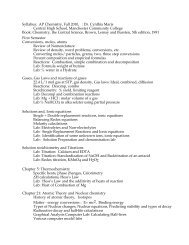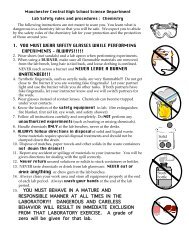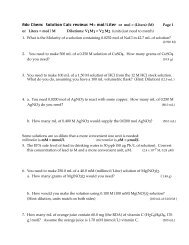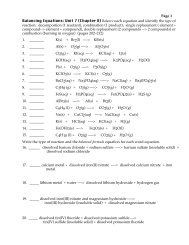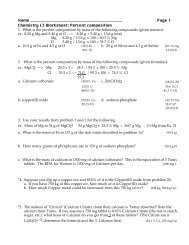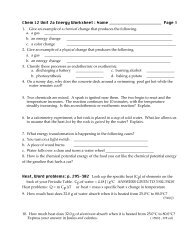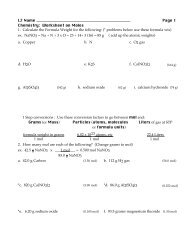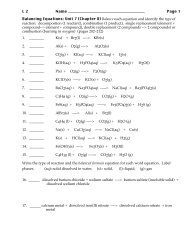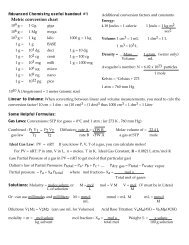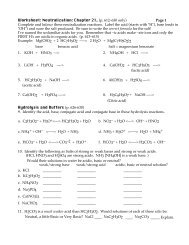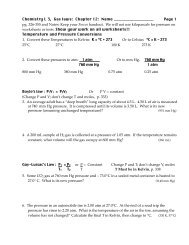Worksheet Electrons
Worksheet Electrons
Worksheet Electrons
You also want an ePaper? Increase the reach of your titles
YUMPU automatically turns print PDFs into web optimized ePapers that Google loves.
Chemistry <strong>Worksheet</strong>: Light : Chapt 13 : p. 372-375 Page 2<br />
1. Arrange the following electromagnetic radiations in order of decreasing wavelength.<br />
a. Infrared radiation from a heat lamp, (b) ultraviolet radiation from the sun, (c) dental X-rays,<br />
(d) the signal from a short wave radio station, (e) green light _______________<br />
2. Arrange the radiation from prob. 1 in order of increasing energy. ________________<br />
Constants and Equations you will need:<br />
!= “nu” = frequency of radiation, Hz, 1/sec or sec –1 " = “lambda”= wavelength of radiation<br />
h = Planck’s constant = 6.63 x 10 –34 Joules–sec c = 3.00 x 10 8 m/sec (speed of light)<br />
c = ! " (Relationship between E = h ! or E = h c (Energy of a photon of light)<br />
frequency and wavelength) "<br />
Metric conversions: 1 x 10 9 nm = 1 m 1 x 10 6 µm = 1 m 1 x 10 3 Hz = 1 kHz<br />
3. a. What is the wavelength in m of radiation whose frequency is 1.5 x 10 15 sec –1 (2x10 –7 m)<br />
b. Convert this wavelength to nm. (200 nm)<br />
c. In what part of the EM spectrum is this radiation ________<br />
d. Does this radiation have a longer or shorter wavelength than red light ________<br />
4. What is the frequency of green light with a wavelength of 5.20 x 10 –7 meters (5.77x10 14 Hz)<br />
What part of the EM spectrum is this radiation<br />
5. Radio Station WTIC AM in Hartford, CT, broadcasts at a frequency of 1080 KiloHz.<br />
a. What is this frequency in Hz (1.08 x10 6 Hz)<br />
b. What is the wavelength in m of these radio waves (278 m)<br />
c. Convert this wavelength to cm. (2.78x10 4 cm)<br />
6. What is the energy of a photon of microwave radiation with frequency = 7.6 x 10 11 sec –1 <br />
(5.04x10 –22 J)<br />
7. What is the energy of a photon of radiation with a wavelength of 6.0 x 10 –5 m Is this more or<br />
less energy than that of Question 6 (3.32 x 10 –21 J)<br />
8. What is the energy of a photon of light with a wavelength of 4.5 x 10 –2 nm What part of the<br />
EM Spectrum is this photon (hint: change nm to m first). (4.42 x10 –15 J)
Electron configurations and notations: p. 367-370 Page 3<br />
Fill in this chart for the electron configuration of these elements<br />
Symbol Atomic Electron configuration Orbital notation (do to Ar only)<br />
_________number_____________________________________________________________________<br />
N 7 1s 2 2s 2 2p 3 #$ #$ # # # (7 arrows)<br />
(7 electrons) (superscripts total 7) 1s 2s 2p<br />
_________________________________________________________________________________<br />
H 1<br />
_________________________________________________________________________________<br />
He 2<br />
_________________________________________________________________________________<br />
Be 4<br />
_________________________________________________________________________________<br />
C 6<br />
_________________________________________________________________________________<br />
O 8<br />
_________________________________________________________________________________<br />
*Ne 10<br />
_________________________________________________________________________________<br />
Mg 12 [Ne]<br />
_________________________________________________________________________________<br />
Al 13 [Ne]<br />
_________________________________________________________________________________<br />
P 15 [Ne]<br />
_________________________________________________________________________________<br />
*Ar 18 [Ne]<br />
_________________________________________________________________________________<br />
1. How many electrons are in the 2nd energy level of : (Add 2s and 2p together!)<br />
Be N O Ne Mg Ar<br />
2. How many electron pairs ( #$ ) are in :<br />
Be N O Ne<br />
You may use the "core method" for the following. Be sure to start with the previous *Noble<br />
Gas. Omit the orbital notation!<br />
Sym. Atomic Electron config. Symbol Atomic Electron config.<br />
number (omit orbitals) number (omit orbitals)<br />
_________________________________________________________________________________<br />
K 19 [ Ar ] 4s 1 Co 27<br />
_________________________________________________________________________________<br />
Ca 20 Br 35<br />
________________________________________________________________________<br />
Sc 21 *Kr 36
Electron configurations and notations: continued Page 4<br />
Sym. Atomic Electron config. Symbol Atomic Electron config.<br />
number (omit orbitals) number (omit orbitals)<br />
_____________________________________________________________________________________<br />
Rb 37 [Kr] Nd 60<br />
__________________________________________________________________________________<br />
Zr 40 Er 68<br />
_________________________________________________________________________________<br />
Sn 50 Ir 77<br />
__________________________________________________________________________________<br />
*Xe 54 Bi 83<br />
__________________________________________________________________________________<br />
Ba 56 [Xe] *Rn 86<br />
_________________________________________________________________________________<br />
Cr 24 (Exception to rule: Will be done in class: Pay attention!)<br />
__________________________________________________________________________________<br />
Questions with Electron configurations<br />
Use your answers from above and the previous worksheet to help you answer Q. 1 – 5<br />
1. How many electrons are in the outside, or highest occupied energy level of the following: (Hint:<br />
Add together the highest s and p sublevels!) Example: Kr has 8 (2 in 4s, 6 in 4p)<br />
C P Sc Br Rb Xe<br />
2. Which of these has an octet (s 2 p 6 ) as its outer electron configuration<br />
Mg Ar Sc Kr Sn Xe<br />
3. Which of these has its 3rd energy level completely filled (Hint: 3s 2 3p 6 3d 10 )<br />
P Ar Ca Co Br Kr Rb<br />
4. Which of these has its 4th energy level completely filled(What sublevels are in 4th level)<br />
Kr Sn Xe Nd Er Ir Bi<br />
5. How many energy levels are occupied in each of the following (Short cut: Row number on<br />
periodic table)<br />
C Mg Ar K Br Rb Zr Xe Nd Bi<br />
6. Which of these orbital notations is a correct, ground state configuration What rule do the<br />
others violate<br />
a. # # #$ # # # c. # $# #$ # # #<br />
1s 2s 2p 1s 2s 2p<br />
b. # $ #$ # # d. # $ #$ # $ #<br />
1s 2s 2p 1s 2s 2p<br />
1) 4, 5, 2, 7, 1, 8; 2) Ar, Kr, Xe (noble gases); 3) Br, Kr, Rb; 4) Ir, Bi; 5) 2, 3, 3, 4, 4, 5, 5, 5, 6, 6) b correct; a& c violate<br />
Pauli Prin. ; d violate Hund's rule
Review questions: <strong>Electrons</strong> : p. 361-383 Page 5<br />
1. What is the wavelength in meters and cm of waves with a frequency of 5 x 10 6 sec –1 . What<br />
part of the EM spectrum is this<br />
(60 m, 6000 cm)<br />
2. What is the wavelength and energy of a photon of with a frequency of 5.80 x 10 14 sec -1 <br />
What color is the photon (3.85 x 10 -19 J)<br />
3. Consider the orbital notation for Oxygen: #$ #$ #$ # #<br />
1s 2s 2p<br />
The "2" in 2s and 2p stands for the ___________, the "p" and "s" stand for the ________<br />
the lines above the "2p" stand for the _____________, and the arrows _____________.<br />
4. Consider the 4th energy level: What sublevels are found there _______________<br />
How many orbitals of each type of sublevel are there ________________________<br />
How many electrons can occupy each of these sublevels___________________<br />
How many electrons are needed to completely fill the 4th energy level _____<br />
5. Circle the correct filling order for the sublevels for elements in the 4th series (K - Kr).<br />
4s 4p 4d 4s 3p 4d 4s 4d 4p 4s 3d 4p<br />
6. Give the electron configuration (1s 2 ) and orbital notation (arrows) for the following:<br />
B _____________ ______________ S<br />
Ni<br />
Omit orbital ______________________<br />
___________ _______________<br />
Calculatrivia for electron configurations: Solve the following.<br />
a. Number of 4s electrons in Sc ______ b. Number of electrons in H ______<br />
c. Highest energy level occupied in Neodymium (Nd) ______<br />
d. Atomic number of the lowest element with an octet ______<br />
e. Atomic weight of element with configuration 1s 2 2s 2 2p 6 3s 1 ______<br />
f. Number of electrons in the highest energy level of Br ______<br />
g. Number of electron pairs in oxygen ______<br />
h. Number of orbitals in the entire 3rd energy level ______<br />
j. Theoretical maximum number of electrons in the 5th energy level (2n 2) ______<br />
k. Theoretical number of sublevels in the 7th energy level ______<br />
m. Lowest energy level with a d sublevel ______<br />
Substitute your answers into the following equation. Then show me the element with this<br />
atomic number<br />
g<br />
(( h m ) – e ) ( d – b) + ( j – ( k f ))<br />
c a<br />
Ans to calculatrivia: a. 2; b. 1; c. 6; d. 10; e. 23; f. 7; g. 3; h. 9; j. 50; k . 7; m. 3



